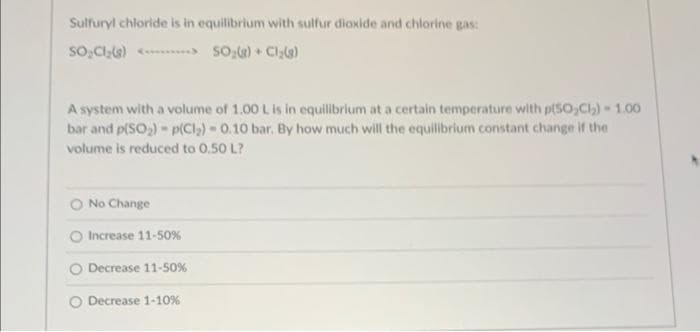For an exothermic reaction, which of the following best describes the effect of increasing the temperature on the forward and reverse reactions? Both the forward and reverse rates increase, but the forward rate increases more than the reverse rate. O Both the forward and reverse rates increase, but the reverse rate increases more than the forward rate. O The forward rate increases while the reverse rate decreases. O The reverse rate increases while the forward rate does not change.
For an exothermic reaction, which of the following best describes the effect of increasing the temperature on the forward and reverse reactions? Both the forward and reverse rates increase, but the forward rate increases more than the reverse rate. O Both the forward and reverse rates increase, but the reverse rate increases more than the forward rate. O The forward rate increases while the reverse rate decreases. O The reverse rate increases while the forward rate does not change.
Chemistry for Engineering Students
4th Edition
ISBN:9781337398909
Author:Lawrence S. Brown, Tom Holme
Publisher:Lawrence S. Brown, Tom Holme
Chapter12: Chemical Equilibrium
Section: Chapter Questions
Problem 12.100PAE: 12.100 A reaction important in smog formation is O3(g)+NO(g)O2(g)+NO2(g)K=6.01034 (a) If the initial...
Related questions
Question
Please do both neat and clean correctly otherwise don't do it...
Thanks

Transcribed Image Text:For an exothermic reaction, which of the following best describes the effect of increasing the
temperature on the forward and reverse reactions?
O Both the forward and reverse rates increase, but the forward rate increases more than the reverse rate.
O Both the forward and reverse rates increase, but the reverse rate increases more than the forward rate.
O The forward rate increases while the reverse rate decreases.
The reverse rate increases while the forward rate does not change.

Transcribed Image Text:Sulfuryl chloride is in equilibrium with sulfur dioxide and chlorine gas:
SO₂Cl₂(g) <> SO₂(g) + Cl₂(g)
A system with a volume of 1.00 L is in equilibrium at a certain temperature with p(50₂Cl₂) - 1.00
bar and p(SO₂) - p(Cl₂) - 0.10 bar. By how much will the equilibrium constant change if the
volume is reduced to 0.50 L?
No Change
Increase 11-50%
Decrease 11-50%
Decrease 1-10%
Expert Solution
This question has been solved!
Explore an expertly crafted, step-by-step solution for a thorough understanding of key concepts.
Step by step
Solved in 2 steps

Knowledge Booster
Learn more about
Need a deep-dive on the concept behind this application? Look no further. Learn more about this topic, chemistry and related others by exploring similar questions and additional content below.Recommended textbooks for you

Chemistry for Engineering Students
Chemistry
ISBN:
9781337398909
Author:
Lawrence S. Brown, Tom Holme
Publisher:
Cengage Learning


Introductory Chemistry: A Foundation
Chemistry
ISBN:
9781337399425
Author:
Steven S. Zumdahl, Donald J. DeCoste
Publisher:
Cengage Learning

Chemistry for Engineering Students
Chemistry
ISBN:
9781337398909
Author:
Lawrence S. Brown, Tom Holme
Publisher:
Cengage Learning


Introductory Chemistry: A Foundation
Chemistry
ISBN:
9781337399425
Author:
Steven S. Zumdahl, Donald J. DeCoste
Publisher:
Cengage Learning


Chemistry: An Atoms First Approach
Chemistry
ISBN:
9781305079243
Author:
Steven S. Zumdahl, Susan A. Zumdahl
Publisher:
Cengage Learning
